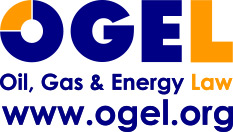OGEL Call for Papers: Special Issue on "Social Licence to Operate (SLO) in the Extractive and Energy Sectors"
3 July 2018
Update January 2020: The OGEL 1 (2020) - Special Issue on Social Licence to Operate (SLO) in the Extractive and Energy Sectors was published in January 2020, table of contents and free excerpt here www.ogel.org/journal-browse-issues-toc.asp?key=84
Dr. J. Górski, Dr. G. Mete, and Hon. C. Trenorden will be editing a Special Issue of Oil, Gas & Energy Law (OGEL, ISSN 1875-418X, www.ogel.org) on the legal aspects of the "Social Licence to Operate (SLO) in the Extractive and Energy Sectors".
The concept of social licence to operate (SLO, simply 'social license' or 'social licensing') originated in the mining industry and its use has also been extended over large infrastructure, energy, and industrial projects. In simple terms, the SLO refers to: 1) "the ongoing acceptance of a company or industry's standard business practices and operating procedures by its employees, stakeholders and the general public" (Investopedia 2018) and 2) "the level of acceptance or approval by local communities and stakeholders of mining companies and their operations." (Fraser Institute 2012). Specifically in the mining sector, the SLO can be summarised as attempts to "to secure the acceptance of mining activities by local communities and stakeholders, in order to build public trust in their activities and prevent social conflict" (IRP UNEP 2017) whereas such attempts "are premised on engagement between mining companies, governments and civil society to ensure that mineral resource extraction contributes to nation-al and local development, and that damaging impacts on host communities and the environment are mitigated or otherwise managed" (ibid.).
The need of the developers/investors to obtain the SLO stems from the "the demands on and expectations for a business enterprise that emerge from neighbourhoods, environmental groups, community members, and other elements of the surrounding civil society" (Gunningham, Kagan, Thornton 2014). In turn, from the perspective of developers/investors, the SLO is "a pragmatic calculation of what is required to minimise business risk and win the degree of community support required to avoid delay or disruption to company operations" (Owen, Kemp 2013). The SLO is based on some agreement between developers/investors and stakeholders/the community and can take a form of 1) "an informal agreement that infers ongoing acceptance of an industrial or energy project by a local community and the stakeholders affected by it" (Gallois, Ashworth, Leach, Moffat 2017) or 2) "a form of unwritten social contract that exists between companies and communities" (Lacey, Lamont 2014)
The lawmakers can assist with the development of agreements for SLO through procedural empowerment of various stakeholders such as by securing 1) access to environmental information, 2) public participation in environmental law making, strategic impact assessment (SEA) or project-specific environmental impact assessment (EIA), and 3) related administrative and judicial review procedures. Moreover, within the framework of sector-specific corporate-social-responsibility (CSR)/ Triple Bottom Line (TBL) activities, developers/investors also seek to secure wider SLO going beyond pure compliance for a number of reasons such as a desire to avoid boycott, or a belief that downplaying such expectations would eventually lead to the adoption of stricter regulation (Gunningham, Kagan, Thornton 2014). Indeed, to quote Curran, "[i]n an age of CSR, social licence thus acts as a form of strategic risk management for most major companies. Its objective is to protect companies' financial and reputational assets by proactively anticipating and managing contestation rather than simply reacting to it." (2017).
Obtaining SLO in relation to the extraction of hydrocarbons and electricity generation is more relevant than ever. On the global scale, the public awareness concerning the impact of new investments and ongoing operations in those sectors on the environment, climate and quality of life of affected communities is constantly increasing, whereas we remain as far as ever from phasing out conventional fuels. About 1600 new coal power plants (CPP) and about 50 nuclear power (NPP) are currently planned or being constructed.
The co-editors invite you to explore the legal dimensions of the controversy surrounding the SLO by contributing to this special edition with unpublished or previously published articles, conference papers, research papers and case studies addressing the SLO and corresponding issues.
The following topics raise interesting points for discussion of the SLO:
- Specific sectors
- prospection, exploration and extraction (upstream) of hydrocarbons, including coal, oil, gas, unconventional hydrocarbons (eg; shale gas, tight gas), coal seam gas/coal bed methane (CSG), underground coal gasification (UCG);
- electricity and heat generation including coal power plants (CPP), gas power plants (GPP), waste to energy (WtE), nuclear power plants (NPP), hydrogen production, and renewables such as hydro power plants (HPP), photovoltaic power plants (PVPP), geothermal power plants (GtPP). biomass heating systems;
- linear investment such as such oil and gas pipelines (midstream) or high voltage electricity transmission grid with emphasis on cross-border interconnectors;
- underground storage of gas, oil and CO2.
- Involvement of public authorities in the social licensing process
- the legislative works with regard to laws affecting above-listed sectors
- the preparation of various plans, programs and/or strategic environmental assessment (SEA) which cover above-listed sectors;
- Environment Impact Assessment (EIA) of specific projects in above-listed sectors;
- Procedural empowerment of stakeholders
- access to information such as on the progress of the legislative process and/or environment-related information,
- public participation in the legislative process, preparation of environment-related plans and programmes, the SEA, the EIA;
- related administrative and judicial review procedures;
- the pros and cons of legislative provision for a charter of public engagement
- the duty to obtain free, prior and informed consent (FPIC) from indigenous communities
- consultation with indigenous communities in relation to law and plan making
- Property rights and taxation
- separation of right to deposits between treasuries and land holders;
- distribution of royalties between treasuries and landholders;
- contractual arrangements between developers/investors and landholders
- expropriations and compensation;
- specific tort regimes in mining and nuclear sectors;
- SLO-related requirement requirements imposed/recommended by:
- major multilateral developments banks (MDBs): World Bank (WB) European Investment Bank (EIB); Islamic Development Bank (IsDB); Asian Development Bank (ADB); European Bank for Reconstruction and Development (EBRD); (CAF); Inter-American Development Bank Group (IADB); African Development Bank (AfDB); Asian Infrastructure Investment Bank (AIIB);
- sub-regional MDBs: Caribbean Development Bank (CDB); Central American Bank for Economic Integration (CABEI); East African Development Bank (EADB); West African Development Bank (BOAD); Black Sea Trade and Development Bank (BSTDB); Economic Cooperation Organization Trade and Development Bank (ETDB); Eurasian Development Bank (EDB); New Development Bank (NDB); OPEC Fund for International Development (OFID);
- national development banks/agencies of major donors: Australia: Department of Foreign Affairs and Trade (Development Cooperation Division); Canada: Global Affairs Canada and the International Development Research Centre (IDRC); China: International Development Cooperation Agency; Denmark - Danish International Development Agency (DANIDA); European Union: EuropeAid department of the European Commission; France: Agence Française de Développement (AfD); Germany - Federal Ministry for Economic Cooperation and Development, Kreditanstalt für Wiederaufbau (KfW); Italy: Ministry of Foreign Affairs: Italian Development Cooperation Programme; Korea: International Cooperation Agency (KOICA); Japan International Cooperation Agency (JICA) and Japan Bank for International Cooperation (JBIC); Netherlands: Ministry of Development Cooperation and The Netherlands Foreign Trade and Development Agency (NFTDA); Norway: Ministry of Foreign Affairs: International Development Program[28] and Norwegian Agency for Development Cooperation (NORAD); Russia: Federal Agency for the Commonwealth of Independent States; Switzerland: Swiss Agency for Development and Cooperation (SDC): Sweden; International Development Cooperation Agency (Sida); United Kingdom: Department for International Development (DFID); United States: Agency for International Development (USAID);
- domestic laws in specific jurisdictions - we particularly invite submissions in covering jurisdictions hosting BRI-related projects.
For example, the following cases could be discussed:
- Afghanistan: Afghanistan: Energy Supply Improvement Investment Program (Solar), Tranche 3 (ADB-funded);
- Argentina: Atucha 3 NPP block; Carem 25 NPP block;
- Armenia: Yerevan Gas-Fired Combined-Cycle Power Project (ADB-funded);
- ASEAN: Expansion of B. Grimm Power Public Company Limited (ADB-funded);
- Austria: Graz hydropower plant (EIB-funded); Deutschlandsberg wind farm (EIB-funded); Simonsfeld Onshore Wind Farm (EIB-funded); Windpark Bruckneudorf-Hoeflein West (EIB-funded);
- Azerbaijan: Shah Deniz Gas Field Expansion Project (ADB-funded); Trans Anatolian Natural Gas Pipeline Project (TANAP) (AIIB-funded);
- Bangladesh: Bhola IPP gas power plant (AIIB-funded); Distribution System Upgrade and Expansion Project (AIIB-funded); Rupsha 800-Megawatt Combined Cycle Power Plant Project (ADB-funded); Rooppur 1 NPP block; SASEC Bangladesh-India Electrical Grid Interconnection Project (ADB-funded); Southwest Transmission Grid Expansion Project (ADB-funded);
- Belarus: Ostrovets 1 and Ostrovets 2 NPP blocks;
- Brazil: Angra 3 NPP Block; Financing of Renewable Energy Projects and Associated Transmission (BNDES) (NDB-funded);
- Cambodia: National Solar Park Project (ADB-funded);
- Cameroon: Sanaga River Hydropower Development (WB-funded):
- China: Beijing Air Quality Improvement and Coal Replacement Project (AIIB-funded), Donghai Bridge Wind Farm; Haiyang 1 and Haiyang 2 NPP blocks; Hongyanhe 5 and Hongyanhe 6 NPP blocks; Jiangxi Industrial Low Carbon Restructuring and Green Development Pilot Project (NDB-funded); Lingang Distributed Solar Power Project, Qingdao Rural Waste-to-Energy and Clean Energy Supply in Rural and Suburban Area Project (ADB-funded); Fangchenggang 3 and Fangchenggang 4 NPP blocks; Fuqing 5 and Fuqing 6 NPP blocks; Shamghai (NDB-funded); Panda Power Plant in Datong, Shanxi; Putian Pinghai Bay Offshore Wind Power Project, Fujian Solar road, Jinan (NDB-funded); Sanmen 1 and Sanmen 2 NPP blocks; Shidaowan NPP block; Taishan 1 and Taishan 2 NPP blocks; Three Gorges Dam, Hubei; Tianwan 4 Tianwan 5 and Tianwan 6 NPP blocks; Xiapu 1 NPP block; Yangjiang 5 and Yangjiang 6 NPP blocks;
- Cook Islands: Battery Storage to facilitate expansion of solar PV-based generation systems in Rarotonga (ADB-funded)
- Cyprus: Kodap Strategic Oil Reserves Storage (EIB-funded);
- Egypt: Access/EREN and ACWA Benban Solar Power Plants (EBRD-funded); Alfa Solar Binban (EBRD-funded); Aswan Solar Project (EBRD-funded); EDF EN Benban PV Solar Power Plant (EBRD-funded); ELSEWEDY Benban PV Solar Power Plant (EBRD-funded); Gulf of Suez Wind Farm (EIB-funded); Infinity/ib vogt Solar Power Plants (EBRD-funded); Kom Ombo Solar Power Plant Project (EBRD-funded); Philadelphia Project Solar Power Plant (EBRD-funded); Red Sea Solar Project (EBRD-funded); Sun Infinite Solar Power Project (EBRD-funded); Zafarana Solar Project (EBRD-funded);
- Finland: Olkilouto 3 NPP block; Pori Energia Biomass Power Plant (under EIB appraisal);
- France, Flamanville 3 NPP block;
- Georgia: Enguri Hydro Power Plant Climate Resilience Upgrade (EBRD-funded); Nenskra Hydropower Plant (ADB and AIIB co-funded); Vardnili & Enguri Hydro Rehabilitation (EIB-funded);
- Greece: Greek Renewable Energy Framework (GREF) (EBRD-funded); Viotia Wind Parks (EIV-funded);
- Hungary: modernisation of Paks NPP
- India: Canara Renewable Energy Financing Scheme (NDB-funded); Kakrapar 3 and Kakrapar 4 NPP blocks; Kalpakkam Prototype Fast Breeder Reactor (PFBR); Kudankulam NPP block; Maharashtra Feeder Separation and High Voltage Distribution System Project (ADB-funded); Rajasthan 7 and Rajasthan 8 NPP blocks; Transmission Improvement Projects in Odisha and Tamil Nadu (ADB-finded);
- Indonesia: Geothermal Energy Upstream Development Project (WB-funded); Gundih Pilot Carbon Capture and Storage Activity in the Natural Gas Processing Sector, Central Java (ADB-funded); Jeneponto Wind Power Plant, South Sulawesi (ADB-funded); Likupang Solar Power Plant, North Sulawesi (ADB-funded); Pringgabaya Solar Power Plant, Selong Solar Power Plant, and West Nusa Tenggara (ADB-funded); West Nusa Tenggara (ADB-funded); Sengkol Solar Power Plant, West Nusa Tenggara (ADB-funded);
- International Waters: Nordlink High Voltage Direct Current Project (Germany-Norway, (EIB-funded); Nordstream 2; Southstream (original Bulgarian destination); Turkish Stream;
- Italy: Italy-France HVDC Interconnector between Savoy and Piedmont (EIB-funded); Rete Gas Infrastrutture VI (EIB-funded); Terna Capri-Continente transmission network (EIB-funded);
- Japan: Ohma 1 NPP block;
- Jordan: Al Safawi Solar PV Project (EBRD-funded); Risha Solar PV Project (EBRD-funded); Shobak Wind Farm (EBRD-funded);
- Laos: Northern Cross-Border Power Trade and Distribution Project (ADB-funded);
- Kenya: Olkaria I Geotherma L Extension (EIB-funded); Power Distribution Last Mile Connectivity (EIB-funded);
- Korea: Shin-Hanul 1 and Shin-Hanul 2 NPP blocks; Shin-Kori 4 and Shin-Kori 5 NPP blocks;
- Kyrgystan: Uch Kurgan Hydropower Plant Modernization (ADB-funded);
- Moldova: Moldova Romania Power Interconnection (EIB and EBRD co-funded);
- Mongolia: Desert Solar Power Project (EBRD-funded); Sainshand Wind Farm (EIB and AIIB co-funded);
- Myanmar: Myingyan Power Plant Project (AIIB-funded); transmission line between Ahlone and Thida (ADB-funded) Mawlamyine-Ye-Dawei transmission line (ADB-funded);
- Nepal: Power Transmission and Distribution Efficiency Enhancement Project (ADB-funded);
- Pakistan: KANUPP 2 KANUPP 3 NPP blocks; Tarbela 5 Hydropower Extension Project (AIIB-funded);
- Peru: Peru Subnational Implementation of EITI (WB-funded);
- Portugal: Tamega - Iberdrola Hydro Power Plant (under EIB appraisal);
- Romania: Transgaz Brua Gas Interconnection Project (EIB-funded);
- Russian Federation: Leningrad II-1 NPP block; Nord-Hydro Project; Novovoronezh II-2 NPP block; Power of Syberia gas pipeline; Pevek Floating Nuclear Power Plants; Rostov 4 NPP block;
- Serbia: Kovacica Wind Farm (EBRD-funded);
- Slovakia : Mochovce 3 and Mochovce 4 NPP blocks;
- Spain: Goya Wind Project, Aragon (EIB-funded)
- Solomon Islands: Tina River Hydropower Project (ADB-funded);
- South Africa: Project Finance Facility for ESKOM (NDB-funded);
- Tajikistan: Nurek Hydropower Rehabilitation Project (WB and AIIB co-funded);
- Thailand: Investment in Gulf Energy Gas Power Plants (ADB-funded);
- Tonga: Outer Island Renewable Energy Project (ADB-funded)
- Turkey: Akfen Solar Power Project (EBRD-funded); Karova Wind Power Plant (EIB-funded); Kizilcaterzi Wind Power Plant (EIB-funded); Mersinli Wind Farm (EBRD-funded); Tuz Golu Gas Storage Expansion Project (AIIB-funded); Uluborlu Wind Power Plant (EIB-funded);
- United Arab Emirates: Barakah 1 Barakah 2 and Barakah 2 and Barakah 4 NPP blocks;
- United Kingdom: SSE Caithness Moray Power Transmission, Scotland (EIB-funded); SGN Gas to the West, Northern Ireland (EIB-funded);
- United States of America: Dakota Access pipeline (DAPL). Keystone XL pipeline (KXL); Three Tar Sands Line; Vogtle 3 and Vogtle 4 NPP blocks;
- Uzbekistan: Power Transmission Project in Tashkent - Railway Electrification Project (Bukhara-Urgench-Khiva) (AIIB-funded); Talimarjan Thermal Power Plant (ADB-funded); Sherabad Solar Power Plant (NDB-funded);
- Viet Nam: Northern to Central 500 kV Transmission Grid Reinforcement Project (ADB -funded); Rural Electrification Project (ADB-funded).
Guest Editors
-

-
Dr. J. Górski
City University of Hong Kong
View profile
-

-
Dr. G. Mete
CEPMLP, University of Dundee
View profile
-

-
Hon. Ch. Trenorden
UCL Department of Chemical Engineering
View profile
More news in the archive.
